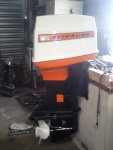Re: Best OMC motors?
I would concur that the FD, RD & JW (JH) motors are probably the best, along with the QD 10-horse. What they have going for them is simplicity, durability, maturity (as in refined & enduring design), parts availability, plus light weight. Honorable mention goes for the Gale 5, 15, 25, 35 & 40 since they were the old familiar Johnnyrudes.
The 18 horse evolved into the 20 for 1966, then was hot-rodded into the 25 for 1969. That 25 was amazing, having 30-mph speed out of an 82-lb. package.
The early 25s were known as Big Twins. They evolved into a 30, then 35. By the time they reached 40 horsepower they gained the super-quiet double-walled lower unit and a more sophisticated cooling system, not that they were complicated. The 40s had large displacement and were understressed, having the simplicity of a single carb. The old 25/30 powerhead & simpler lower unit re-emerged as the 28, then they got the bigger powerhead and continued as a 33. After 1970 the 33 & 40 lines merged into an economy 40 (actually something the Gale division at OMC had done years earlier). They were in continuous production through 1976, then continued in some locals as a Commercial 40 into the mid-1980s.
The cute little 3-horse was smooth, light, simple, reliable and long-lasting. It evolved into the 4-horse for 1969 and carried on into the 1980s. It was also the same powerhead that the 1980+ 4.5-horse was based on, so honorable mention goes to them.
The 5? was also an excellent motor, and evolved into the 6 that ran through 1979. The 7? was also very good in its day but it went out of production after 1958. The result is certain powerhead parts are harder to get a hold of since they did not have the production run and evolution of the little 5.5 ? 6. Still a very nice motor, but the 10 is better.
Ah, the 10. It pioneered the F-N-R gearcase & remote fuel tank that forever changed boating. It was a jewelled powerhead, which means it used needle-bearing races to reduce oil requirements & increase rebuildability. OMC refined the F-N-R gearcase over a relatively short span and it went on to serve in the 18-20-25 after it was deemed to be over-engineered for the 10. For 1958 the 10 got a lighter version that essentially was derived from the 5? & 7?. The 10 ran in that form through 1963.
I love the little 9? that was produced from 1964-1973. To me they are quite compact, well balanced, full-featured, and in just under the 10-horse limit. Not everyone shares the enthusiasm. For one thing, they are more involved to work on due to the compact nature. They do not naturally lend themselves to remote controls, though OMC had an elaborate kit for those that wanted to (BRP still has the parts to do it). I think they are very functional, but others have referred to them unflatteringly as ?The Turtleback?. Beauty is in the eye of the beholder.
Those motors were in turn replaced by the 9.9 & 15 for 1974. They were a beautiful, powerful compact package that was not without its idiosyncrasies. There were tradeoffs; the early versions had the easy to service breaker point ignition but tended to foul plugs and were not the greatest trollers (especially the 15), while the CDI models 1977-on ran better but suffered from the ?replaceable, expensive black box? syndrome. The whole package was refined over its long run and really was quite a nice motor. They were available with electric start in the same compact package. The electric start models had a full charging system, something the vaunted FD-series 15-18-20-25 never had.
Some of my boating friends think I am crazy to belong the 2-stroke camp.




















